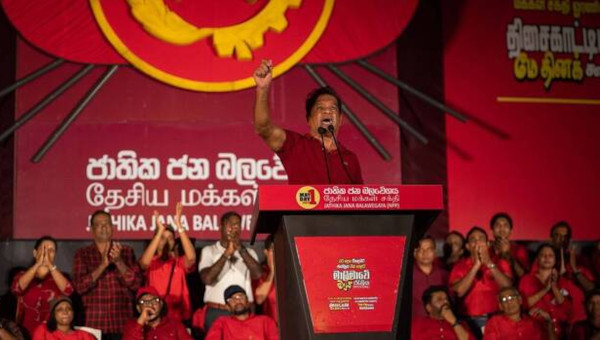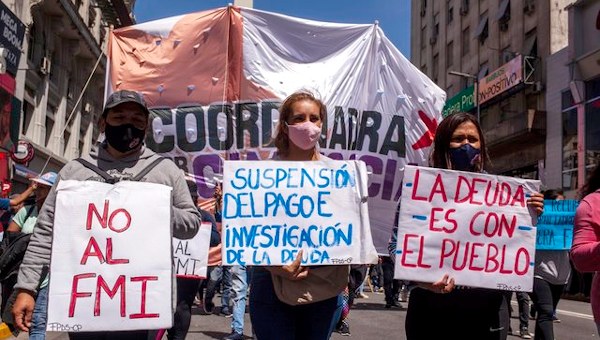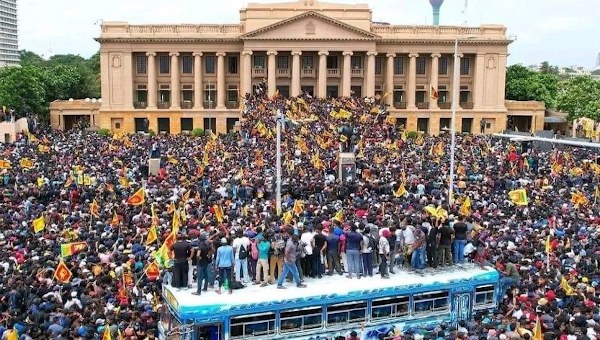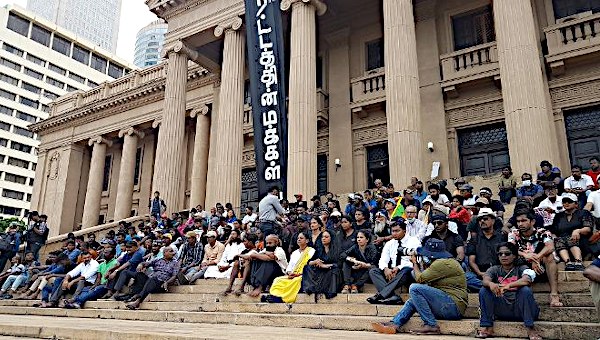Sri Lanka: Crisis of Neoliberalism and the Progressive Alternative
The current crisis in Sri Lanka is not only a political crisis of the regime of Gotabaya Rajapaksa. It is also a structural breakdown of the way in which neoliberalism has historically attempted to legitimise its own regime of accumulation. According to one framing of the debate, while the Rajapaksa regime is going backward, neoliberal elements within the Opposition embrace a forward-looking agenda. But both represent two provisional attempts to resolve the problems generated by the neoliberal regime, without necessarily transforming it in a deeper, structural sense.
In the case of the Rajapaksa regime, it is attempting to borrow from a heterodox policy toolkit while preserving the basic conditions of private sector-led accumulation that have characterised the neoliberal regime. Meanwhile, elements within the Opposition propose a radicalisation of free market reforms, to achieve the same goal. Both the Rajapaksa regime and this segment of the Opposition seek to reform the system to restore it, although they take different approaches.
Yet in a moment where the “old is dying and the new cannot be born,” the system itself must undergo transformation, lest it generate the morbid symptoms to which Gramsci famously referred. In the dialectic of struggle between regime and opposition, there is the possibility that potentially fascist elements empowered by the regime could displace it and ultimately claim to provide a more radical solution to these intractable problems. Ultra-nationalists may attempt to appropriate the discourse of self-sufficiency. Meanwhile, if the Opposition takes power by pursuing an even more aggressive neoliberal approach, it could initially attempt to legitimise itself in terms of the mandate given by the International Monetary Fund (IMF) or other external actors. But it would still impose severe costs on the public.
Accordingly, once in government, the current Opposition would be unable to reconstruct the bases of its own hegemony, or at the very least it would be severely constrained in its space for manoeuvre because of its willing subordination to external forces. The fascist solution would also eventually acquire power in this scenario, albeit on a more uncertain timeline. Of course, the fascist solution has its own limitations precisely because of the dependent nature of Sri Lanka’s economy, its increasing subordination to external powers with their own geopolitical interests, potential domestic resistance along cross-ethnic lines, and so on. All these factors must be considered. But they beg the question: what is the alternative?
Today, the question for the Left is not about how, as in Britain in the 1970s, we transform an existing social democratic State that has reached its limits (Hall 1980). Instead, it is: how do we create an entirely new progressive regime? Often, this question invokes pre-existing notions, including stereotyped attributes such as a robust welfare system, mixed economy characterised by State intervention in strategic sectors, and so on. But if we are willing to push ourselves, the crisis in Sri Lanka means taking seriously the fundamental re-envisioning of the hegemonic bloc that is materialised in the State. The challenge requires first explaining why the crisis of neoliberalism has erupted, and the way in which neoliberals themselves interpret the crisis.
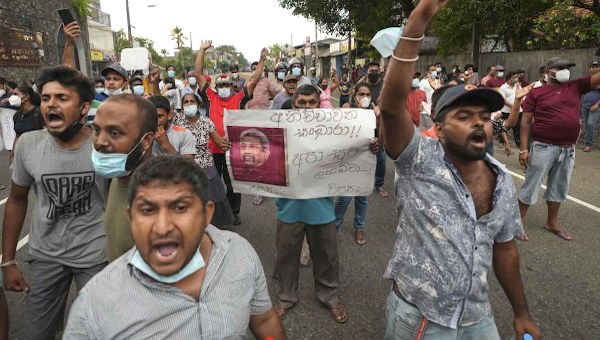
The Discursive Shift within Neoliberalism
The question of what constitutes neoliberalism has been asked so many times that by this point it may feel stale. Rather than try to suppress the concept, however, by exploring contradictions in its articulation as an ideology by specific actors – regardless of whether they themselves self-identify as neoliberals – we can better understand what its failings are. This approach can enable us to ask what is required to transcend its fundamental inability to resolve the current crisis.
Of course, there is no monolithic body of neoliberal thinking. It is the shifting expression of a network of experts. It is constantly being reformulated to emphasise different elements in its constellation, though its overall direction remains to assert the domination of the market over society. By engaging with the discourse, however, we can reconstruct a general shift in thinking: from a perception of the process of reform as a necessary component of Sri Lanka’s economic growth since the inauguration of the ‘open economy’ in 1977, to the contemporary argument that reform itself has not been taken up with sufficient vigour.
Initially, neoliberalism was confident of its success in redefining the terrain of debate. As Athukorala and Rajapatirana (2000) put it in a representative text, “Following two decades of reforms, Sri Lanka today stands out as one of the most open economies in the developing world. This basic policy orientation seems set to continue in the foreseeable future” (546). The authors, writing during the global apex of neoliberalism in the late 1990s and early 2000s, asserted that whatever administration came to power in Sri Lanka could only accelerate the process.
Athukorala and Rajapatirana identified key variables to explain why the open economy was successful on the terms they set forth, including the apparent growth of the export-oriented manufacturing sector. According to them, “The promotion of foreign investment, particularly in export-oriented manufacturing, has been a pivotal element of Sri Lanka’s market-oriented policy reforms since 1977” (550).
They further identified the core features of the investment-promotion policy package offered by the Greater Colombo Economic Commission (GCEC) – which later became the Board of Investment (BOI) – to Export Processing Zone (EPZ) investors. It notably “[allowed] complete foreign ownership of investment projects; a tax holiday for up to 10 years with complete tax exemption for remuneration of foreign personnel, royalties, and dividends of shareholders during that period; duty exemption for the import of inputs and assistance with customs clearances; industrial services at subsidised rates; and unlimited access to foreign currency credit at interest rates prevailing in world financial markets” (550).
In the present moment, however, neoliberalism’s policy prescriptions have shifted in response to the growing contradictions within this process. As Mick Moore (2017), for example, has demonstrated, “institutionalised pressure for tax exemptions” contributed to the hollowing out of Sri Lanka’s revenue base, which helped create the fiscal crisis we observe today (13). Yet for the neoliberal elements within the contemporary Opposition, the primary culprit remains unsustainable State expenditure.
Among representative actors, the Advocata Institute, for example, has come out with successive statements blaming the crisis on the Rajapaksa regime’s attempts to impose price controls and import restrictions, along with continued support for a bloated public sector and inefficient State-Owned Enterprises (SOEs). These elements, however, require a systematic form of explanation. They are in fact attempts, however ineffective, to restore, rather than overcome, the overall direction of the neoliberal economy. The Rajapaksa regime is trying to manage the most severe impacts of the crisis on different constituencies, whose support is critical to its political survival.
Given the massive scale of the crisis, of course, the emergency measures that the regime pursues are inevitably insufficient. In some cases, they may even be strategic miscalculations. For example, the fertiliser ban. Failed attempts at price controls and import restrictions are part of the current regime’s hesitant and muddled response to the crisis.
The confusion is embedded in the fact that the regime itself does not want to break with the fundamental model of private sector-led accumulation that has characterised the economy since 1977. This reluctance is evidenced both by its initial expansion of tax concessions and, more recently, its manoeuvring within the budget to ply investors with more incentives. Perhaps the most obvious example is the way in which easy money has fuelled stock market speculation, without incentivising investment in critical areas such as food production.
These immediate responses to the crisis aside, neoliberals have also redoubled their critique of long-standing institutions that mediate the relationship between State and society. Public sector employment and SOEs are at the core of the neoliberal ideological assault on the Rajapaksa regime’s alleged failure to implement necessary reforms. Accordingly, the narrative has shifted from the exhilarating days when Athukorala and Rajapatirana could claim all governments in Sri Lanka had adopted major elements of the neoliberal consensus, to sombre attempts to identify the reversal of this process around the time the Rajapaksas first came to power in 2005 under Mahinda.
So, for example, Advocata has argued that “The present macroeconomic instability lies in the failure of the state to implement deep structural reforms to the economy for nearly twenty years. The COVID-19 pandemic has exposed Sri Lanka’s fundamental weaknesses that have plagued the economy for a long period of time.”
Why Neoliberals Can’t Explain the Crisis of Neoliberalism
The contemporary attempt to bifurcate the open economy into good and bad phases, however, fails to comprehend two dimensions necessary for analysing the crisis: the relationship between financialisation and the political legitimacy of the State. In terms of the first issue, the consequences of the intersecting crises of “twin deficits” (meaning, the budget and the current account) are the expression of a longer structural trend. The rise of neoliberalism and the reduction of State revenues are inter-related. Specifically, revenue as a proportion of GDP declined from 20 to 13 per cent over a nearly 20-year period from 1995 to 2014 (Moore 2017: 6).
This process eventually forced the State to look for other sources to finance its expenditure – namely, dollar-denominated loans – while bilateral and multilateral donors that offered concessional funding exited over time. Or as Moore notes, “… Until 1977 the fiscal deficit averaged just under a third of government revenue collection; after 1977 it averaged just over half. And it remained there even after aid levels began to decline” (18-19). Once finance capital became dominant, some slowly began to recognise what others had already been pointing out, which is that it was cannibalising the system.
A wider, global debate about the extent to which financialisation is the necessary outcome of neoliberalism continues. As Fine (2014) puts it:
“A crucial point is that despite its ideology, neoliberalism is not about the withdrawal of state (economic) intervention; it has always been associated with a strong not a weak state, and an authoritarian one as opposed to one that upholds personal liberties. On the contrary, the distinguishing role of the (advanced) neoliberal state has primarily been to promote the interests and internationalization of capital in general and of finance in particular, an important example being the extent that state finance itself has been financialized” (58).
Fine alludes to the example of the US bailout of the banks during the Great Recession of 2008. But the same broad argument can be applied to Sri Lanka. The regime of Mahinda Rajapaksa began issuing sovereign bonds in 2007; a perfect example of State finance becoming financialised.
The deeper logic is that Sri Lanka has had to issue more and more debt because the proposed benefits of globalisation have failed to materialise in a sustainable overall balance of payments. Attributing this squeeze solely to the political choices of the regimes since 2005 evades the core questions of why finance capital has expanded across the globe to seek out speculative opportunities, and why it became attractive to successive regimes as a way of bridging the import/export gap.
This process intersects with the second dimension of the problem, which is the political legitimacy that a regime of accumulation requires. By attacking State spending in general, the contemporary crop of neoliberals completely misunderstands the way in which the current Rajapaksa regime, for example, remains embedded within the logic of neoliberalism. Although the State sustains and perhaps even increases spending in specific areas, such as public sector employment, this does not imply a rejection of neoliberalism. Rather, it is merely one element in its continuation. It may help create the necessary political stability, such as a regime extending its networks of patronage. In this regard, during the current moment, the regime of Gotabaya Rajapaksa is desperately trying to hold on, despite growing fiscal pressure.
Meanwhile, the historical trend has been that most people continue to experience overwhelmingly precarious livelihoods; a process in which inequality has become even more entrenched. In contrast to the neoliberals, some explicitly attempting to give ideological cover to the current regime celebrate its rhetoric and strategies as an example of the ways in which it is not neoliberal. But by ignoring the structural ways in which neoliberalism overdetermines the State in general, they implicitly accept the simplistic neoliberal framing of the ‘market’ as opposed to the ‘State’. In contrast, there is a much longer tradition of scholarship that explains why it has been impossible for neoliberalism to appear in unalloyed form.
It helps to look to an earlier period to reinterpret this question, to bracket the terms of the current debate in which neoliberalism apparently can only be understood in relation to the Rajapaksas’ political choices. Herring (1987), for example, identified the ways in which Sri Lanka could initially avoid the shock of economic liberalisation because the IMF and World Bank were willing to accommodate its expansionary fiscal policy. But that leeway ended by the early 1980s. Subsequently, increasing fiscal pressure led to privatisations and attempts to cut various subsidies, which provoked further popular responses, including contributing to the defeat of the United National Party (UNP) in 1994. This dialectic of neoliberal reform and resistance continues to evolve.
Neoliberal thinking, however, has tended to ignore or dismiss the question of the balance of class forces. It stands in stark contrast with the predominant mode of political science scholarship on Sri Lanka that has attempted to explain why the masses did or did not revolt in key moments. For example, Athukorala and Rajapatirana (2000) initially proposed that “In a decisive move to infuse momentum into the unfinished reform process, a significant second-wave liberalisation package was implemented in 1990” (546). But they avoided a political economic explanation of why neoliberalism was forced to take a step back in response to popular pressure.
Samarasinghe (1994) commenting on the 1994 election results identified several reasons for the switch from the previous UNP government to the People’s Alliance (PA), including the fact that “Two PA election promises were particularly attractive to the farmers: restoration of the fertiliser subsidy for rice farmers that was withdrawn in 1990 under World Bank pressure, and the writing off of outstanding farm loans held by banks and provision of interest-free loans from the banks in the future” (1028). Within this type of explanation, there is space to engage with the question of the ways in which a hegemonic bloc secures the basis of a political regime.
The takeaway is that since consolidating its victory throughout the 1980s and 1990s, neoliberalism has exhausted itself as an ideological process capable of explaining its own ability to work on popular sentiments, to exploit the contradictions within a pre-existing system. Instead, convinced of its own success in dismantling the social democratic State, it became incapable of explaining the emerging tensions within its own bloc. In the current moment, it works itself into a frenzy by demanding that its proposals take tactical precedence in framing the Opposition’s political attack on the Rajapaksa regime. But it has simultaneously abandoned the strategic challenge of reconstructing its bloc.
The Progressive Alternative
Ultimately what this contradiction implies is the fundamental political instability of any future regime that attempts to embrace neoliberal prescriptions. Political leaders among the Opposition may attempt to moderate their approach and restrain the most extreme free market factions within their broad coalition. They may talk of expanding targeted safety nets and maintaining social welfare. But the reality is that given the tremendous scale of the crisis, they will ultimately be forced to make a fundamental choice in terms of whether to restore or revolutionise the current system. The stakes of the crisis do not allow for an inoffensive ‘national consensus’. Instead, they demand a clear articulation of whether to transform the existing system.
The primary axis of differentiation is whether Sri Lanka will radically restructure its imports, or whether it will continue to fall prey to the neoliberal illusion of global market integration via the reciprocal expansion of imports and exports. The latter dynamic would supposedly allow the country to escape the debt trap by exploiting its comparative advantage. The past 45 years of the open economy, however, cannot be drawn up in terms of a favourable balance sheet for this project.
The crisis has come to a head. The question now is whether the ongoing neoliberal attempt to reproduce and extend this crisis into the foreseeable future can be politically sustained. The determining factor is the direction toward which Sri Lanka’s elites will swing in response to the breakdown of existing patterns of accumulation and popular resistance.
Meanwhile, for the Left to play its part in constructing an alternative progressive bloc that can sustain a regime over the long term, it must clarify its purpose. As stated at the beginning, unlike the crisis of the 1970s, the question before us now is not how to push past the limits of the social democratic State. Instead, it is the question of how we create a new type of progressive regime.
To pursue this idea, we must replace the problematique of the transition to an inevitable endpoint – historically, Communism – by recognising a plurality of different paths to social transformation. Past debates within the Left often assumed the technological transformation of society – or the linear development of the forces of production – within which the narrower, more instrumental question of the relationship between the State and the autonomous organisations of the working class was posed.
But we must now acknowledge that as much as we want to revolutionise the current system, this project must not imply the revolution as the ultimate expression of a “technocratic utopia, based on domination of nature, women and colonies” (Mies 2014: 216). The specific historical arrangements and contradictions that emerge will depend on who pushes and how. We can strengthen the ideological framing of this struggle. We cannot, however, anticipate the series of transformations that will ultimately lead to the transcendence of capitalism. We must maintain the latter in terms of broad perspective, given capitalism’s own tendency to dismantle its compromises. This process creates the conditions for further crises that inevitably undermine capitalism’s legitimacy. But we must also recognise the need to pluralise our own imagination of what society could become.
This is where the question of what it means to radically restructure imports takes on a far deeper significance than an alternative understood in narrow economic terms. If we talk about substituting food imports, for example, how would it shape people’s habits and diets, including the potential impact of a public distribution system? If we talk about reducing oil imports, a proxy for energy consumption, how would this require changes in the design of the built environment and public transportation? If we talk about reducing pharmaceutical imports, how would this generate new questions about ways in which to remove pressures within people’s livelihoods, including confronting the social determinants of health?
There is no easy technocratic solution to this set of problems. But a response need not be conceived in terms of harsh restriction of people’s consumption. It could instead provoke creative thinking about alternatives. Above all, this process hinges on the forms of engagement between intellectuals and masses, to analyse problems in the concrete circumstances of people’s lives, and the balance of forces within which solutions are adopted.
Ultimately then, the crisis of neoliberalism and the need to envision a new type of progressive regime are a massive task for the Left, for which there are no pre-existing answers. But by pushing the limits of thought to consider the precise extent of the crisis and what it implies for the overall transformation of the system, we can propose truly radical solutions that could reconstruct the State on more egalitarian grounds. This includes specifying the relationship between the State and community organisations, such as cooperatives. We must recognise, for example, that there is nothing inherently better (or worse) about centralised versus decentralised production; a debate, for example, that has long been taken up by heterodox thinkers.
Instead, these are relational questions that we must pose and interpret in a non-economistic way, including by asking the ways in which they intersect with caste, gender, and other modes of social power. Within an alternative hegemonic arrangement, elites will identify opportunities for accumulation and thus come to their own accommodation with the new status quo. We cannot anticipate the exact outline of the society that emerges at the end of this process. But there is also hope. Insofar as neoliberalism is unable to solve the crisis it has created, we now have an opportunity to radically reorient the entire debate about what is possible, beyond its narrow strictures. •
References
- Athukorala, Premachandra and Sarath Rajapatirana. (2000). “Liberalization and Industrial Transformation: Lessons from the Sri Lankan Experience.” Economic Development and Cultural Change, 48(3): 543-572.
- Fine, Ben. (2014). “Financialisation from a Marxist Perspective.” International Journal of Political Economy, 42(4): 47-66.
- Hall, Stuart. (1980). “Popular-Democratic vs Authoritarian Populism: Two Ways of ‘Taking Democracy Seriously’.” In Alan Hunt (Ed.). Marxism and Democracy (157-185). London: Lawrence and Wishart.
- Herring, Ronald. (1987). “Economic Liberalisation Policies in Sri Lanka: International Pressures, Constraints and Supports.” Economic and Political Weekly, 22(8): 325-333.
- Mies, Maria. (2014[1986]). Patriarchy and Accumulation on a World Scale: Women in the International Division of Labour. London: Zed Books.
- Moore, Mick. (2017). The Political Economy of Long-Term Revenue Decline in Sri Lanka. International Centre for Tax and Development (ICTD) Working Paper 65. Brighton: Institute of Development Studies.
- Samarasinghe, S. W. R. de A. (1994). “The 1994 Parliamentary Elections in Sri Lanka: A Vote for Good Governance.” Asian Survey, 34(12): 1019-1034.
This article first published on the SSA website.


